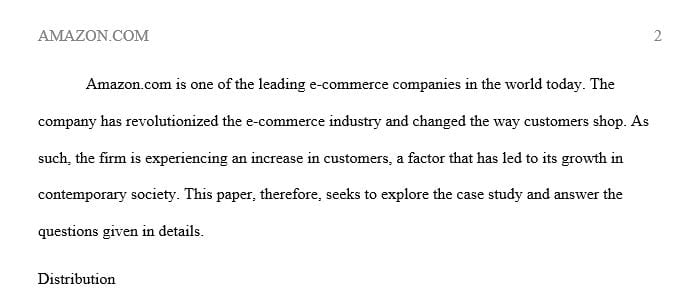Why has Amazon succeeded when so many other companies have failed
Evaluate the case of your choice, and respond to each of the questions below using both theory and practical managerial thinking as well as supporting research.
Option 2: Amazon.com (pp. 522–523)
With respect to the distribution, why has Amazon succeeded when so many other companies have failed?
From a theoretical standpoint, what is Amazon’s pricing model? Why is this so effective? How does this compare to their competitors?
Discuss how Amazon has used differentiation and positioning as two key components in maintaining a competitive advantage.
Thinking about the changes in the macro and micro environment, what is next for Amazon? Where else can it grow?
In formatting your case analysis, do not use the question-and-answer format; instead, use an essay format with subheadings. Your APA-formatted case study should be a minimum of 500 words in length (not counting the title and reference pages). You are required to use a minimum of three peer-reviewed, academic sources that are no more than 5 years old (one may be your textbook). All sources used, including the textbook, must be referenced; paraphrased material must have accompanying in-text citations.
Marketing Excellence
Amazon.com Founded by Jeff Bezos in 1995, Amazon.com started as the “world’s largest bookstore” and, ironically, owned no books. Bezos promised to revolutionize retailing, however, and over the years he has blazed a trail of e-commerce innovations that many executives have studied and companies have followed. Amazon initially set out to create personalized storefronts for each customer by providing more useful information and more choices than found in a neighborhood bookstore. Readers could review books and evaluate them on a one- to five-star rating scale, while fellow browsers could rate the reviews for helpfulness. The company’s personal recommendation service aggregated buying-pattern data to infer who might like which book. Amazon also introduced its revolutionary one-click shopping, which allowed buyers to make purchases effortlessly with a single click. Amazon started to diversify its product line in the late 1990s, first with DVDs and videos and then with consumer electronics, games, toys, software, video games, and gifts. The company continued to expand its product offerings and in 2007 launched Amazon Video On Demand, allowing consumers to rent or purchase films and television shows to watch on their computers or televisions. Later that year, it introduced Amazon MP3, which competed directly with Apple’s iTunes and had participation from all the major music labels. Amazon’s most successful product launch was the Kindle, its branded electronic book reader that delivered hundreds of thousands of books, magazines, blogs, and newspapers in a matter of seconds. As thin as a magazine and light as a paperback, the device has been the company’s best-selling product since 2009. Today, you can find virtually anything you want on Amazon.com. The company has successfully established itself as the biggest online retailer in the world by enabling merchants of all kinds to sell items on the site. In addition to its core business, Amazon also runs an “Associates” program that allows independent sellers and businesses to receive commissions for referring customers to the site in a variety of ways, including direct links and banner ads as well as Amazon Widgets, mini-applications that feature the company’s wide selection of products. Associates can create an Amazon-operated online store easily, with low risk and no additional cost or programming knowledge. Fulfillment by Amazon (FBA) takes care of picking, packing, and shipping the merchant’s products to its customers. One consistent key to Amazon’s success is its willingness to invest in the latest technology to make shopping online faster, easier, and more personally rewarding for its customers and third-party merchants. During peak season in 2012, the company sold approximately 306 items per second, or 26 million items per day. Small wonder that it continually looks for ways to improve delivery. For a $99 annual fee, Amazon Prime provides unlimited free express shipping for millions of items. While free shipping and price cuts are sometimes unpopular with investors, Bezos believes they build customer satisfaction, loyalty, and frequency of purchase orders. In 2013, Amazon.com announced a partnership with the U.S. Postal Service to begin delivering orders on Sundays. Bezos also predicted on 60 Minutes that the company may use drones in the near future to make same-day delivery of lightweight products within short distances of distribution warehouses. (Critics find this unlikely for many reasons, though.) Amazon has also maintained competitive and low prices throughout its product expansion. The company understands how important it is to keep its prices low in order to drive the volume it needs to remain a market leader and expand geographically. Amazon’s practice of selling books at heavily discounted prices, however, has upset some of its channel partners in publishing, as have its attempts to become a publisher in its own right. From the beginning, Bezos has said that even though he started an online bookstore, he eventually wanted to sell everything to everyone through Amazon.com. The company continues to invest significantly in technology, is focused on the long term, and has successfully positioned itself as a technology company with its wide range of Amazon Web Services. This growing collection of infrastructure applications meets the retailing needs of companies of virtually all sizes. Amazon has successfully reinvented itself time and again and created a critical channel for merchants around the world who are able to reach more than 244 million customers worldwide.
Reference
Kotler, P., & Keller, K. L. (2016). Marketing management (15th ed.) [VitalSource Bookshelf version]. Upper Saddle River, NJ: Pearson. Retrieved from https://online.
Solution preview for the order on why has Amazon succeeded when so many other companies have failed
APA
720 words
